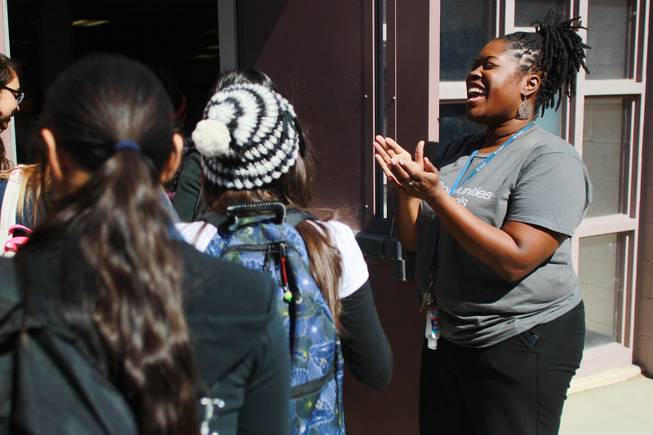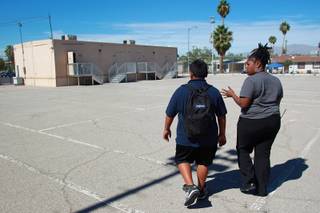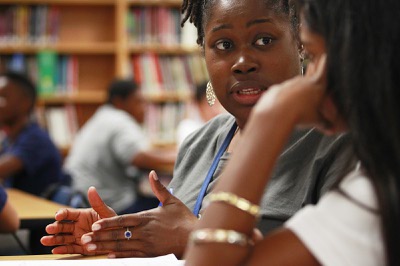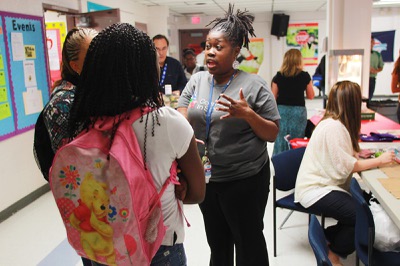
Las Vegas Sun
Communities in Schools site coordinator Kalah Washington cheers students as they make their way to lunch Tuesday, Oct. 9, 2012, at Bridger Middle School.
Saturday, Oct. 13, 2012 | 2 a.m.
Sun coverage
Program results
Communities in Schools serves 22,000 students in 37 schools across the state, 12 of them in Southern Nevada. The nonprofit group provides basic resources as well as counseling to help children graduate in a state where 133 students drop out of school every school day.
CIS has seen improvements at target schools in Clark County. Here are some of the program's key results, according to CIS:
• About 95 percent of program participants were promoted to the next grade level. About 90 percent graduated from high school.
• At the elementary school level, the attendance rate improved by 52 percent. In the middle and high school levels, the attendance rate improved by 73 percent.
• At the middle and high school levels, students' grade-point averages improved by 62 percent.
In the wake of the Great Recession, Las Vegas schools have become more than just places where students learn.
In some of Clark County’s poorest neighborhoods, schools are full-service community centers, offering free medical and dental services, food and clothing and even assistance with utilities and rent. One of these schools — Whitney Elementary in the eastern valley — received national attention for its efforts to help students, many of them homeless.
But often, principals of these schools — such as Whitney’s Sherri Gahn — split their valuable time making sure their students are properly educated and also ensuring the students’ home needs are adequately met. It’s a tough act to juggle, but ultimately, it’s difficult for children to learn if they’re hungry or worried about whether the lights will be on when they get home.
Enter Communities in Schools, a nonprofit group that is helping principals at 12 Clark County schools offer various wraparound services to needy children. Two years ago, the local chapter of the national organization began placing site coordinators at the 12 campuses to help principals and staff deliver services with the help of other nonprofit groups and resources.
Kalah Washington is the site coordinator at Bridger Middle School, where 84 percent of its 1,300 students participate in the federal free and reduced-price lunch program. Armed with little more than a hand-held radio and telephone, the energetic 27-year-old Georgia transplant is on the front lines of an effort to combat the effects of poverty on children’s education.
Washington is always on the move, bustling from one corner of the school to another and helping anyone who needs it. Her radio is constantly abuzz with requests.
"I’m here to take the burden off of teachers and administrators," said Washington, who is sponsored by Communities in Schools. "These kids always brighten my day, no matter how my day is going. I love it."
A few years ago, Bridger opened a community resource center inside a sand-colored portable classroom. The center — sponsored by Communities in Schools and supported by groups such as Three Square Food Bank, the Salvation Army and Goodwill — houses pantries full of canned goods, clothes and school supplies for students and their families.
Nearly every day, there are calls to Washington’s radio from teachers and nurses requesting clean shirts and pants for children who show up to school in raggedy attire. Children who can’t afford school supplies are given free pencils and paper.
More than 400 students have taken advantage of the free school supplies since the start of the year. About 20 families rely on Bridger’s food pantry and clothing depot on a monthly basis.
And the center isn’t just a resource for Bridger students. If a Bridger student has siblings attending other schools, Washington wants to help them, too.
"We try to help them all," she said.
However, Washington’s job extends beyond fulfilling some of the basic needs that students have. She counsels upwards of 72 students who need academic and personal help through one-on-one and group sessions.
Washington eschews taking these students out of class to counsel them. It just doesn’t make sense, she said.
"If you’re failing your class, why should I take them out of class to talk to them about failing class?" she said. "I try to do a lot of it in the in-between time."
So, during breakfast and lunch and in between classes, Washington can be found pulling her "kiddos" aside, chatting them up about their day and how they’re doing in class. Through her big smiles, high-fives and jokes, Washington is building relationships and rapport with students.
"How’s your mom doing?" she asks one student. "How’s the new baby?"
"Your backpack is ripped here," she tells another. "Do you want another one?"
Some students need more hands-on attention. That’s when Washington brings them to the resource center for a 15-minute counseling session.
On a recent day, Fernando is called into Washington’s room. Fernando is struggling in class.
"What do you think your grades are looking like?" Washington asks as she pulls up Fernando’s grades on a computer.
He’s failing in world geography. He hasn’t been doing his homework.
"It’s like the Olympics," Washington tells Fernando in a stern voice. "You’ve got to train and practice, or else you’re gonna get cramps."
After the counseling session, Washington writes a note to herself to check up on Fernando in a few days. If Washington’s students don’t show up to her counseling session, she’ll send reminders and even hunt them down during class to quickly follow up.
Even though Washington doesn’t teach a class, she’s interacting with students nearly every minute of the day. She’s on lunch duty, ensuring that kids are eating their meals, cleaning up after themselves and making sure they’re not getting into trouble. She also tutors about 20 students for an hour after school, helping with homework.
In between her busy schedule, Washington hits the phones, calling nonprofit groups and businesses to help Bridger. Currently, she’s working on getting donations for turkeys to send home to more than a dozen needy families for Thanksgiving. Soon, Washington will be organizing a gift drive for the winter holidays.
In her two years at Bridger, Washington has become a part of the school fabric, said Principal Deanna Jaskolski. Washington’s enthusiasm and personal talks have helped build relationships with students and staff alike, Jaskolski said.
In the process, Washington has bridged the gap between the school and the community, bringing outside resources to students and allowing administrators and teachers to focus on educating students.
"Knowing that someone outside of school cares helps teachers and students immensely," Jaskolski said. "It’s made a tremendous difference on campus."




Join the Discussion:
Check this out for a full explanation of our conversion to the LiveFyre commenting system and instructions on how to sign up for an account.
Full comments policy